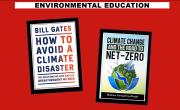Written by: Catherine Binuya, Ed.D.
Presentation Overview 
Elba Pareja-Gallagher is the UPS Sustainability Director (https://about.ups.com/us/en/social-impact/environment/sustainable-services/sustainability-trailblazer-elba-pareja.html) and ShowMe50 Founder (https://www.showme50.org/author/elba/). She presented on the origins of the sustainability movement and the current implications of ESG (E—Environmental Care, S—Social Responsibility, G—Government Ethics), and why it is important in global politics and business.
Takeaways
- The background of sustainability—
- Sustainability spurs innovation. Industries must be able to adapt and adopt ESG to save costs, and create opportunities, and thrive and grow.
- SEC (U.S. Securities and Exchange Commission) in the news—
- The SEC ruled, in March 2022, to require publicly traded companies to report on extensive climate related information and climate risks, via financial statements, e.g., Green House Gas (GHG) emissions, financial implications, Carbon Footprint. Set goal for US industries to be Carbon Zero by 2050.
- Time travel—why ESG?—
- The ESG movement is rooted in pivotal events across each decade beginning with the Vietnam War giving rise to social-political activism in the 1970’s; to the focus of socially responsible investing in the 1990’s-2000’s; to global-political initiatives such as the Paris Agreement, UN Sustainability Goals, impact of COVID-19 and Black Lives Matter (BLM) in 2010’s-2020’s.
- Drill down of ESG—
- Environmental Care includes considerations for: air pollution, water pollution, carbon emissions, energy efficiencies, waste reduction, water conservation, biodiversity. Fact: processing concrete accounts for 8% of global emissions.
- Social Responsibility includes considerations for: equity, diversity, labor standards, customer protections, production responsibilities, human rights, human capital.
- Government Ethics includes considerations for: board diversity, executive pay, audit structures, shareholder democracy, ethics and compliance, anti-corruption, lobbying, IT security and cyber risks.
- Diagram of the balance and intersection of E, S, G—
- Successful sustainability is achieved by balancing the needs of stakeholders at the intersection of all three E, S, and G (e.g., venn diagram model).
- The UN (United Nations) defines sustainability as: meeting the needs of the present without compromising future generation’s ability to meet their own needs.
Additional Recommended Resources:
-
-
- Podcasts: MSCI ESG Now, SNP Global ESG Insider, Green Biz
- Books: “How to avoid a climate disaster: The solutions we have and the breakthroughs we need” by Bill Gates, “Climate Change and the Road to Net-Zero” by Dr. Matthew Hampshire-Waugh
-
Next Event
Join us at the next PMI Atlanta AEC forum (TBD)
Register at www.pmiatlanta.org/events/event-calendar




